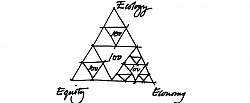cradle-to-cradle by William McDonough & Michael Braungart
William McDonough & Michael Braungart created the cradle-to-cradle certification.
http://www.mcdonough.com/writings/cradle_to_cradle-alt.htm
http://www.mbdc.com/detail.aspx?linkid=1&sublink=6
Waste=Food.
The processes of each organism in a living system contribute to the health of the whole. A fruit tree's blossoms fall to the ground and decompose into food for other living things. Bacteria and fungi feed on the organic waste of both the tree and the animals that eat its fruit, depositing nutrients in the soil in a form ready for the tree to take up and convert into growth. One organism's waste becomes food for another. Applied to architecture, these cradle-to-cradle nutrient cycles can serve as models for the design of materials and building systems that eliminate the concept of waste. Materials designed for use in cradle-to-cradle cycles, for example, can be either safely returned to the soil or re-utilized as high-quality materials for new products.
The Human Leaf
Applied to design, the laws of nature give architects, designers and planners a set of principles that allow them to articulate in form a building's or a town's connection to a particular place. They allow us to create buildings that make the energy of the sun a part of our metabolism and apply it to positive human purpose-the building as "human leaf." The principles, illustrated by the life of a tree, are:
Use current solar income.
Living things thrive on the energy of the sun. Simply put, a tree manufactures food from sunlight, an elegant, effective system that uses the earth's only perpetual source of energy income. Buildings that tap into solar income-using direct solar energy collection; passive solar processes such as daylighting; and wind power, which is created by thermal flows fueled by sunlight-make productive and profitable use of local energy flows.
Celebrate diversity.
"The tree" provides not just one design model but many. Around the world, photosynthesis and nutrient cycling, adapted to locale, yield an astonishing diversity of forms. Bald cypress, desert palm, and Douglas fir suggest a range of niches. The hundreds of tree species within a single acre of Southern Appalachian forest suggest the diversity of a single region. Architects and planners, applying a diversity of design solutions, can create buildings and cities that fit elegantly and effectively into their own niches.
cf attached pictures on basic scheme for cradle-to-cradle concept and fractal ecology model for a sustaining design( http://www.youtube.com/watch?v=0OFI1Tx2EGU&feature=related )
China’s Grand Plans for Eco-Cities Now Lie Abandoned
And William McDonough — a U.S. architect, author of Cradle to Cradle, and a celebrated figure in the American green architecture movement — worked on the design of Huangbaiyu, as well as “conceptual plans” for other eco-projects across China. The sentiments voiced by McDonough several years ago typified the grand aspirations of the eco-city planners. In a slideshow presentation now available on YouTube ( http://www.youtube.com/watch?v=eY4o3WzCfmM ), he said, “I will finish by showing you a new city we’re designing for the Chinese government. We’re doing 12 cities for China right now, based on Cradle to Cradle, as templates. Our assignment is to develop protocols for the housing of 400 million people in 12 years …”
Today, with increasingly critical coverage of eco-cities in the press, McDonough’s architecture and community design firm, William McDonough + Partners, is downplaying its involvement in China. According to Kira Gould, the firm’s director of communications, “While we have in the past done some very limited conceptual planning work in China, we are not doing any community design/planning work there at this time.”
http://e360.yale.edu/feature/chinas_grand_plans_for_eco-cities_now_lie_abandoned/2138/


